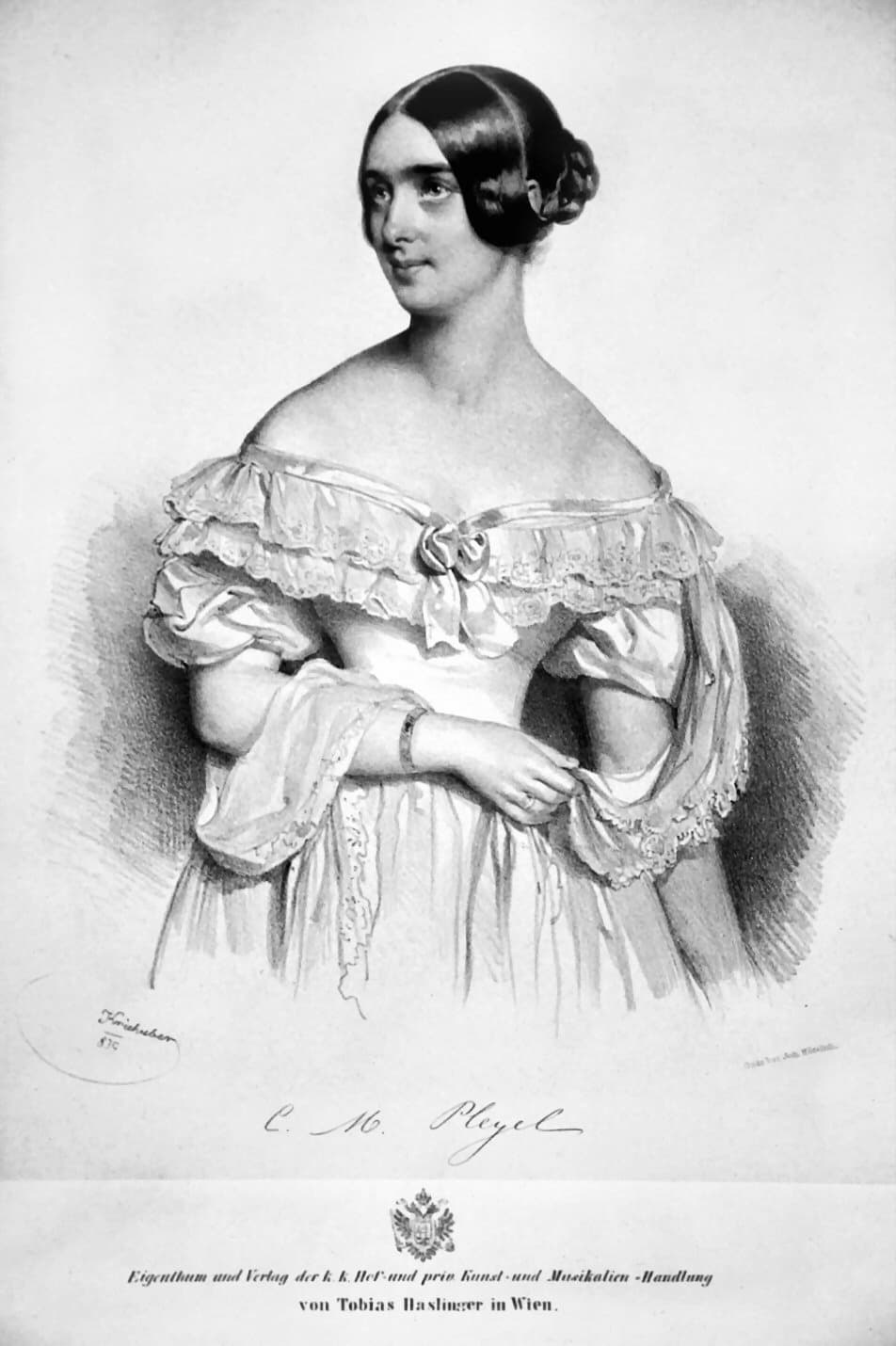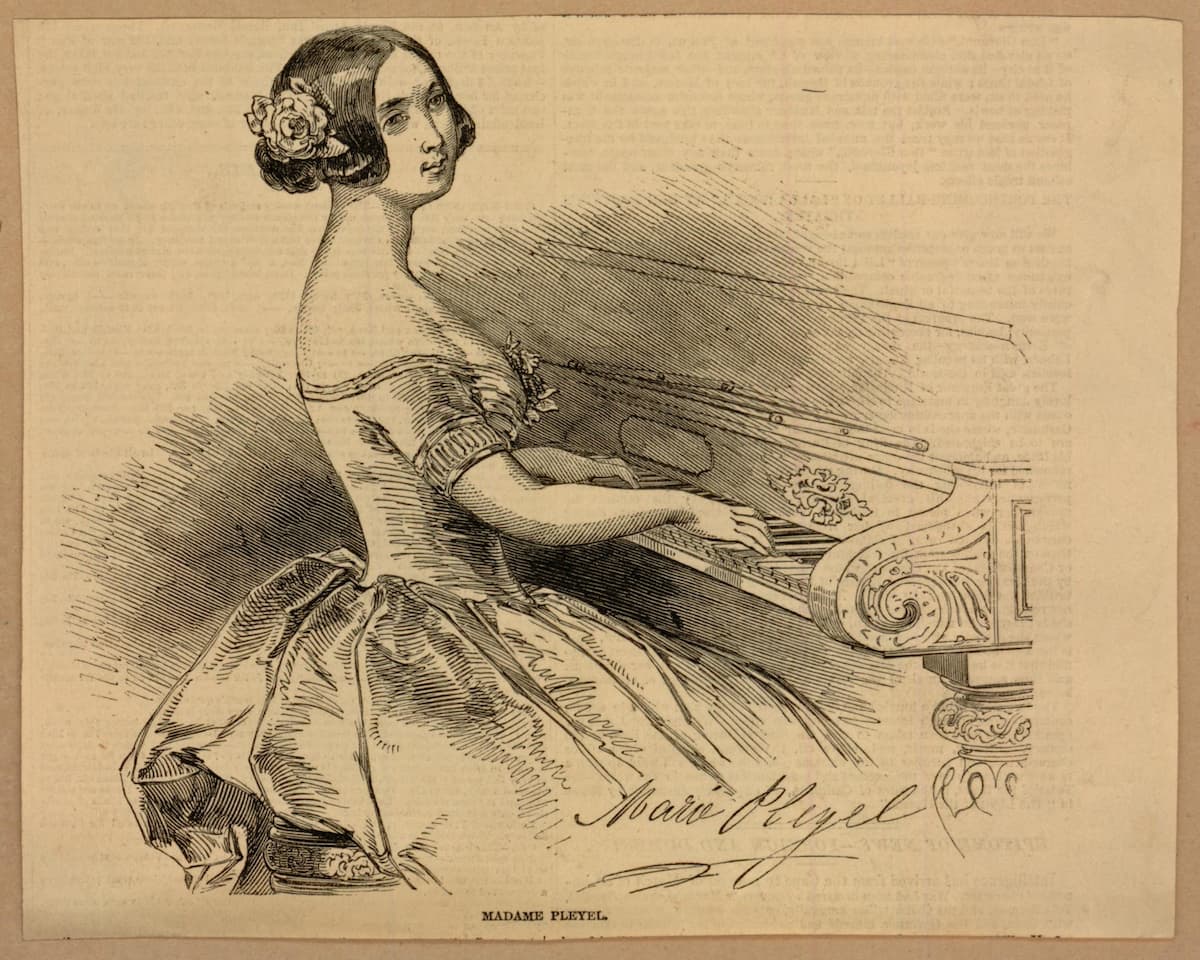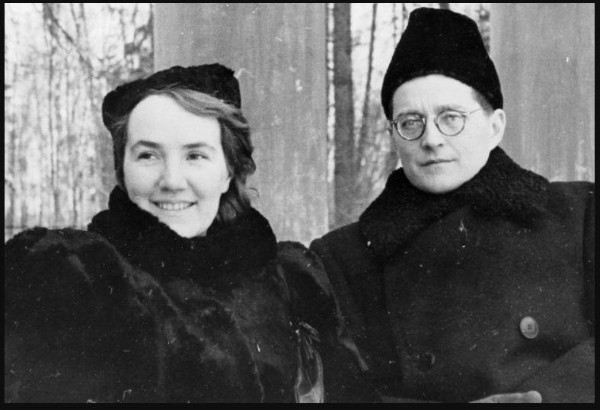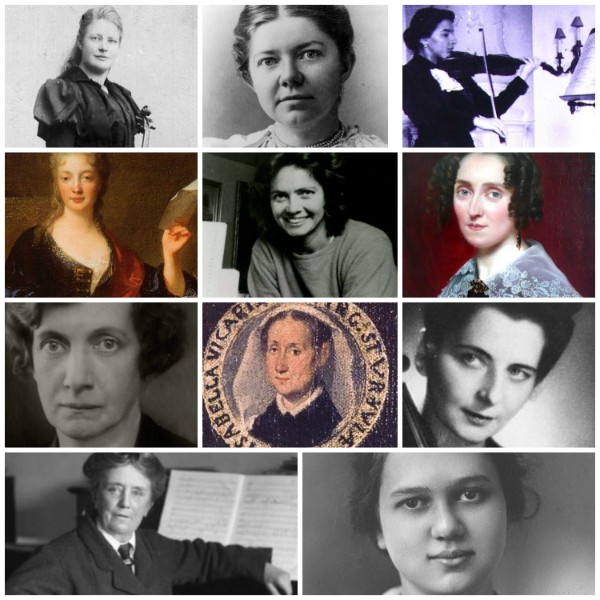She was among the greatest pianists of the nineteenth century…and yet if music lovers know her name at all, it’s because she made a terrifying cameo in Berlioz’s memoirs. Today we’re looking at the life of great pianist Camille Marie Moke Pleyel, and how she was an important part of the lives of classical music legends like Franz Liszt, the Schumanns, and, yes, Hector Berlioz.
Childhood and Early Musical Training

Marie Moke-Pleyel (lithograph by Josef Kriehuber, 1839) © Wikipedia
She was born Marie-Félicité-Denise Moke in 1811 in Paris and nicknamed Camille. Her father was a Belgian language teacher and her mother was a German-born shop owner (one source indicates that she sold lingerie).
We don’t know a lot about Camille’s early music talent, but it must have been impressive. She began her studies as a four-year-old with the well-connected teacher Jacques Herz, whose brother was one of Paris’s most famous piano teachers. At nine, she started studying with Ignaz Moscheles, the man who taught Mendlessohn. Finally, as a teenager, she finished her studies under the preening piano sensation Friedrich Kalkbrenner, a performer much admired by Chopin. She played her first big debut concert at fourteen in Paris.
Falling in Love with Berlioz
A few years later, she heard the sad story of a young and emotionally unstable composer named Hector Berlioz, who had fallen madly in love with a Shakespearean actress named Harriet Smithson and then written an entire symphony (now known as the Fantastique) about his obsessive love for her. Camille in turn fell in love with him and boldly told him her feelings. She was eighteen and Berlioz twenty-six. They became a couple in the spring of 1830, began a physical relationship, and were engaged to be married. “If only you could hear my Camille, thinking aloud in the divine works of Beethoven and Weber, you would lose your head as I do,” Berlioz wrote to a friend.
Camille Pleyel: Nocturne a la Field in B Major, Op. 52 (Masha Dimitrieva, piano)
However, Camille’s mother was hesitant about the wisdom of the match. Despite the fact that Berlioz was older, Camille earned much more money than he did through her teaching and concertizing. So, motivated by his love for Camille, he pushed himself to win the Paris Conservatoire’s prestigious Prix de Rome, which he did in August 1830. That December, he set off to claim his prize of two years of study in Italy. Before he did, he conducted the premiere of the Symphonie Fantastique in Paris, with Camille in the audience. She was heard to cry out, “Superb, superb, prodigious!”
Breaking It Off With Berlioz – And Marrying Someone Else

But she had second thoughts – possibly due to the extremes of Berlioz’s emotions, or a fear of a loss of independence. In April 1831, while Berlioz was still in Italy, she married a middle-aged pianist twice her age named Camille Pleyel. On paper at least, it was an exponentially better match than the one with Berlioz. Camille Pleyel was from a wealthy and well-connected piano manufacturing family that owned its own hall in Paris, and Camille encouraged his future wife to continue teaching and playing piano after her marriage: a freedom that not many other potential husbands would have allowed her. She did, however, decide to change her name, going by Marie instead to differentiate herself from her new husband, turning from Camille Moke to Marie Pleyel.
Berlioz had a terrifying reaction when he read the letter from her mother announcing her marriage. He famously wrote in his memoirs, “In two minutes my plans were laid. I must hurry to Paris to kill two guilty women and one innocent man; for, this act of justice done, I, too, must die!” He bought a dress in which to disguise himself as a maid, loaded his pistols, and set off to Paris. Luckily by the time he got to Nice he changed his mind and returned to Rome.
Life After Marriage…and Hooking Up with Liszt
In 1832, Chopin made his debut at the Salle Pleyel. Around that same time, perhaps in tribute to both her artistry and the support shown by her husband’s family, he dedicated his revolutionary Nocturnes Op. 9 to “Madame Camille Pleyel.”
Frédéric Chopin: Nocturne No. 1 in B-Flat Minor, Op. 9, No. 1 (Pascal Rogé, piano)
When she was with Pleyel, she had two children. Unfortunately, after they were born, her marriage quickly fell apart. In 1834 her husband actually requested a separation on account of her multiple infidelities. As of right now, scholars don’t know anything more about who she was romancing… Maybe in the future, we’ll learn more.
We do, however, know a little bit about her love life after her marriage. In 1835, Liszt asked Chopin if he could borrow his apartment while Chopin was away. Chopin agreed readily enough. Later he was horrified to learn that Liszt had used the space to rendezvous with Marie. The discovery of them was the occasion of a falling out between Chopin and Liszt, as well as Chopin and Marie. Liszt and Marie’s lives and careers would continue to intersect over the coming years, and they never lost their personal fondness and professional respect for each other.
A New Start to Her Career and Meeting the Schumanns
In 1836, Marie withdrew from public life for a few years to focus on her studies and perhaps to take stock of how she was going to manage her life as a single working mother.
In 1839, she felt secure enough in her musicianship to take her talents on the road. She garnered rave reviews. One critic wrote, “She is more than a man, than a great artist, she is more than a pretty woman; at the piano she has no gender, following the picturesque expression which she herself employs.”
In November 1839, Robert Schumann wrote to his soon-to-be fiancée Clara Wieck about Marie, calling her “definitely an artist in everything she does and speaks. She also has a habit of sometimes shutting her left eye and looking upwards with the other in a most gorgeous manner, and this is so sweet it can take your breath away.”
When Robert Schumann first met Marie, he was delivering a message sent by a mutual friend. Eccentrically, she received him while laying in bed. They talked for two hours. Marie loved smoking cigars, and before he left, she stuffed his hat and coat pockets full of them.
Clara Wieck Schumann was alarmed by Marie’s success. She was convinced that there was only room on the concert circuit for one great female pianist, and she was fretful that Marie would take the crown. “Everything I read about her is increasingly clear proof that she must be placed above me, which can only mean total defeat for me,” she wrote despairingly. It turns out she had nothing to fear, and both women enjoyed major careers. When the two finally met in 1851 during one of Clara’s tours to Brussels, she wrote, “I was very pleased to meet her since I had heard so much about her, and I was actually very surprised by her great amiability which seemed so perfectly natural.”
Later Career

Tomb in Laeken Cemetery, Brussels © Wikipedia
Marie toured all over Europe, traveling from London to Vienna to St. Petersburg to everywhere in between, in a performing career that lasted for decades.
In 1839 she arrived in Vienna while Liszt was monopolizing audiences’ attention there. The two pianists were staying at the same hotel, and she came to visit him to suggest a genius PR plan: he would walk her onstage at her first performance, providing his symbolic endorsement of her artistry and creating a buzz in the audience. The ploy worked. He also offered to perform a duet with her, which upset his then-girlfriend Marie d’Agoult.
Liszt paid tribute to his adored colleague when he dedicated two pieces to her during the 1840s: “Réminiscences de Norma” and “Tarantelle di Bravura” to Marie. Ahead of the Réminiscences’s publication, Liszt wrote a playful tongue-in-cheek letter to her: “Such is the sorcery of your person and your talent that if you would only not disdain to run through these few pages of Reminiscences with your inimitable fingers I have not the slightest doubt that they will present themselves as something new and will product the most magnificent effect.”
Zoltan Kocsis plays Franz Liszt’s Reminiscenses de Norma
In 1848, she began teaching at the Brussels Conservatory, where she taught until 1872. She died in 1875.
Her Legacy
Camille Marie Moke Pleyel’s connection with so many famous men – and especially her appearance in Berlioz’s influential and rather spiteful memoir – colored her legacy as a cold and heartless ice queen, and consequently her many professional accomplishments and her intensely charming personality have been ignored. However, looking at the full history, it is clear she was actually a major figure at the center of nineteenth-century musical life, and an artist worth getting to know in her own right.
For more of the best in classical music, sign up for our E-Newsletter


